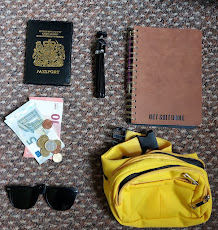Kit
- Waterproof inner rucksack cover by Osprey.
- First Aid Kit.
- Paracord clothes line.
- Nurofen and sun cream.
- Spare glasses.
- Power pack and leads.
- Wall socket adaptor.
- Kinesiology and Zinc tape.
- Nail clippers.
- Ear plugs.
- Sewing kit.
- Nappy pins for hanging clothes.
- Loo Roll.
- Folding mug.
- Spare laces.
2nd Pic
- Hiking socks.
- Pants.
- Shower shoes.
- Shorts.
- Body wash.
- Soap.
- Towel.
- Hiking brolly.
- Quick dry shirt.
- Wicking T shirt.
- Base layer Fleece.
There is no need to take a camp
bed, a cooker a tent or even food. It's not that type of journey. There are
small villages, towns and even major cities along the way, there are plenty of
opportunities to stock up on gear. There are cafe's and bars for
refreshments, fountains for water (and one for wine) and accommodation for
sleeping along the whole route.
At the time of writing this, I know nothing about walking the Camino, but whilst serving for many years in the Army, an organisation that knows a lot about walking and foot care, I was taught what is really, really important about foot care. It's not your choice of footwear. It doesn't mean more expensive is better, It's not the type the style, the brand, the colour or whether or not they are waterproof, but the fitting. Proper fitting and comfortable footwear is crucial if you want to look after your feet. Put some miles on them, get them worn in. Mould them to your feet. Thank me later.
Your socks have to be of seriously good quality and they also have to fit properly, it doesn't matter if you choose to wear a thin liner and a thicker outer, or just one pair, so long as friction (and therefore heat) against your skin is kept to an absolute minimum. Take rests, let your feet breathe and keep them dry. That's my plan.
What I'll be walking in.
- Merrell MOAB 2 Gortex.
- Darn Tough hiking socks.
- Keffiyeh Shemagh.
- Neck rag.
- Buff.
- Quick dry hiking trousers.
- Long sleeved hiking shirt.
- Sun hat.
- Fingerless gloves.
- Gortex gaiters.
2nd Pic. Sundries.
- Passport.
- Euros.
- Mini tripod.
- Journal.
- sunglasses.
- Bumbag.
- Osprey Kestrel 38 litre Rucksack.
- 1 litre chill water flask.
- Waterproof gloves.
- Sweat rag.
- Clip on torch.
- Knee support.
- Waterproof jacket.
Not shown is a very lightweight sleeping bag (Only 380gms) and a windproof jacket.
My choice of rucksack was a given, as I have had it for some time now and by chance it's a common sight on the Camino, probably because Osprey have been building quality packs for nearly 50 years and it's an excellent tool. Air ventilation for the back, easy to reach grab pockets at the sides, zipper pouches on the waist belt for sundries, clips all over the shop for water bottles, phone, carabiners, umbrellas, cameras and ice picks, (really!) and there is plenty of room to easily hold all of my gear. It comes with a fitted waterproof cover and is extremely comfortable.
In ultra modern terms though, it is classed as a heavy rucksack, weighing in at a massive 1.5kg, but with that in mind, all of the items that I will be taking (less what I am wearing) including the rucksack weighs a total of 5.5 kg. I have to put a litre of water into the water bottle and of course one litre of water weighs 1kg, so my starting weight, full up is 6.5kg.
The widely accepted rule of thumb when it comes to carrying weight in a rucksack, is that it really shouldn't exceed 10% of your body weight.
Dripping wet from the shower, I weigh a trim 76kg so I come under that recommendation by enough of a margin that I could comfortably add another litre of water should the need arise, so I'm happy with my kit.
I know that should I come across any Sherpas on the trail, they will definitely not be calling me 'brother.'










Wow 😯
ReplyDelete